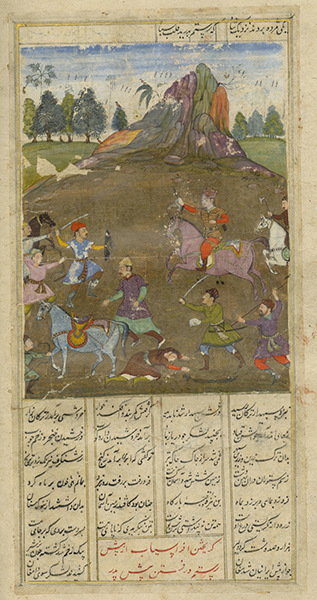5 Persian (Farsi)

Shāhnāmah, translated as The Book of Kings, is the world’s longest epic poem and the most important national book of Persia, written by Abu’l-Qasim Mansur (later known as Ferdowsi Tusi). Shāhnāmah took over a period of thirty years, under the patronage of the Samanid dynasty, to get complete (in 940-1019 or 1025 CE). It resurrected Persian language, history, pre-Islamic beliefs, traditions, and culture almost 400 years after the Arab invasion of the Persian Empire. Being composed of approximately 50,000 couplets (two-line verses), Shāhnāmah chronicles histories, legends, and myths of Iranian (Aryan) kings from the primordial and pre-Islamic era to the 7th-century Arab conquest of Persia. As a “source of popular narratives” and a collection of interrelated dāstāns (mythical prose narratives rooted in the tradition of oral storytelling) the book spans the history of fifty generations of kings and rulers with an emphasis on justice, humanity, faith, and peacefulness.1 All 62 stories told in 990 chapters vividly illustrate scenes of war to imply heroism and wisdom, but also peace, compassion, and reconciliation. These mythic stories define life as a process of living in between light and darkness, as well as between justice and injustice. In describing the stories of Shāhnāmah, Hamid Dabashi, a well-known Iranian scholar, states:
“Ferdowsi’s epic narrative describes the heroic deeds of Rostam, the treacheries of Zahhak, the innocence of Seyavash, the bedeviling attraction of Sudabeh, the tragedies of Sohrab and Esfandiar, the love stories of Bizhan and Manizheh, Zal and Rudabeh. What holds these stories together is Ferdowsi’s self-conscious presence. His periodic interruptions of the epic narrative to dwell on the nature of human beings and their destiny, his unfailing moral gaze at the glories and atrocities of human existence.”2
Ferdowsi’s Shāhnāmah employs the least Arabic loanwords, despite the fact that during the time of its composition, a considerable number of Arabic terminologies were adopted by the Persian language and used in the ordinary language. Many commentators including Mohammad Djafar Moïnfar, claim that Ferdowsi consciously and intentionally avoided using Arabi terms due to existing hostile political circumstances. According to Moïnfar, Shāhnāmah “contains 706 words of Arabic origin occurring a total of 8,938 times.”3 In fact, the emphasis of Shāhnāmah on the Persian language listed the book among the greatest nationalist books of Persian classic literature.
Contribution by Shahrzad Shirvani
PhD Student in Architecture, College of Environmental Design
Sources consulted:
- Encyclopaedia Iranica Online (accessed 5/20/20)
- Hamid Dabashi, The World of Persian Literary Humanism (Cambridge, Mass: Harvard University Press, 2012), 91.
- Encyclopaedia Iranica Online (accessed 5/20/20)
Title in English: The Book of Kings
Author: Abū al-Qāsim Firdawsī
Imprint: India?, 1575-1625?
“As for the place of origin, the scribe was evidently of Iranian background and training, even if living in India, while the paintings are clearly to be distinguished as Indian. It seems that the calligrapher and painter (there were at least two of them) did not work in the same period” – from description of F. Abdullaeva.
Edition: Origin: As appears in colophon on p.1236/fol.615b, copied by ʻAbd al-Qādir Sāvajī al-Qazvīnī with transcription completed 7 Jumādá II in an unspecified year. F. Abdullaeva, Oleg Akimushkin, and Philippa Vaughan refer the manuscript’s production to the latter 16th or early 17th century.
Language: Persian (Farsi)
Language Family: Indo-European, Indo-Iranian
Source: HathiTrust Digital Library (University of Michigan)
URL: https://catalog.hathitrust.org/Record/006805735
Other online editions:
- A manuscript copied in Herat (c. 1444) for the Timurid Prince Muhammad Juki (1402-1445) has been digitized by the University of Cambridge. (accessed 5/20/20)
- A manuscript Copied by Qiwām ibn Muḥammad Shīrāzī in 998 H [1589 or 90], likely produced in Shīrāz, has been digitized by Princeton University Digital Library. (accessed 5/20/20)
- A manuscript imprinted in Iran (1430) and calligraphed by Ja’far has been digitized by the Library of Congress.
- Digitized Illustrations of Shāhnāmah, British Library. (accessed 5/20/20)
- Shahnama: 1000 Years of the Persian Book of Kings by The Smithsonian’s Museum of Asian Art. (accessed 5/20/20)
Select Print editions at Berkeley:
Many editions and translations can be found through UC Library Search. The most precious is an abridged manuscript of Shāhnāmah in prose believed to be created in India in the early 17th century and is housed in The Bancroft Library.
- Firdawsī. Tārīkh-i dilgushā : Shāhʹnāmah-i nas̲r : [India] : ms., [10]26 [1617 or 1618].
Bancroft Vault 4MS PK6455.A1 1617

